Wedding traditions in Russia are a mixture of ancient Russian rituals, traditions of the Soviet period and Western trends. Recently, more and more often we can see Western-style weddings being held in Russia: with on-site registration, without toastmaster, competitions, accordion player, ransom and loaf, but still the majority still prefer classic Russian weddings. In this article we will take a closer look at how a traditional Russian wedding takes place.
Traditions before the wedding
Wedding traditions among different nations have their differences caused by the peculiarities of culture, beliefs, and way of life. But there are also common features. Even in our time, many families celebrate weddings according to the ancient customs of their people, trying to observe as accurately as possible the rituals that have come down from time immemorial.
However, life does not stand still. Many traditions lose their original meaning and become a thing of the past. Modern newlyweds perceive weddings differently than their grandparents. For them, this is a deeply personal holiday, filled with hints, gestures and meaning that are understandable only to two lovers. Mutual feelings come first, and the interests of families remain behind the scenes. But even fifty years ago, many young people got married under pressure from their parents and other relatives!
That is why most of the previously accepted rites and rituals have completely lost their meaning and now look funny and absurd. However, abandoning outdated traditions does not mean at all that the wedding has turned into another boring feast. Quite the opposite! Information technologies available to everyone have allowed newlyweds to collect touching, beautiful rituals and traditions from all over the world, invent something of their own, unusual, creating their own unique wedding scenario. The holiday turns out to be truly original, spectacular and very individual, which is almost impossible to achieve by following ancient customs.
Bachelor and bachelorette parties
This is one of the most popular modern wedding traditions, although farewell to a free life was organized back in the days of our distant ancestors, but then the gatherings of the newlyweds with their friends were of a different nature. For example, brides did not have fun at all, but cried bitterly, even if they didn’t want to, because they were supposed to be sad about leaving their father’s house.
Today, no one cries at bachelor and bachelorette parties, at least most of the time. At get-togethers with friends and girlfriends, it is customary to rejoice and have fun, and in such a way that there will be enough emotions for the entire married life, because it is not known when the company will be able to gather in full force - work, life and children can upset all plans over and over again.
Wedding outfit
At different times and among different peoples, the color and style of wedding dresses were strikingly different. Until now, in China, for example, brides traditionally wear a bright red dress embroidered with gold. Once upon a time in Rus', the color red symbolized the beauty of the bride; it is not for nothing that in fairy tales the maidens are all, as if by choice, “red.” But with the advent of Christianity, traditions changed. Initially, white chlamys were worn by girls going to the monastery; they were called “Christ’s brides.” Then the white color of the wedding dress came into worldly life, becoming a symbol of purity and innocence.
Until the revolution, traditions ordered the maiden bride to wear a white dress at her wedding. Even now, most girls cannot imagine getting married without a magnificent white dress, although the original meaning of the ceremony has long been no longer observed. However, the dress can be anything. Modern wedding fashion gives complete freedom in choosing the shade for your outfit. He can be:
- creamy and golden;
- red and blue;
- burgundy and pink;
- green, turquoise and even black.
It is permissible to combine different colors, decorating a white or cream dress with contrasting embroidery, a belt, or lace. Or use a smooth transition of shades of the same color from saturated to lighter ones.
Well, an outfit already worn by someone causes subconscious rejection. An old superstition has taken root too deeply in us, saying that by wearing someone else’s wedding dress, the bride thereby “takes over” the unfortunate fate of her predecessor. Whether this is true or not, science cannot explain. But it is rare that a bride wears someone else’s clothes to her wedding, unless she is absolutely sure that the woman’s marriage turned out to be happy.
Ancient traditions prohibit women who have been married from wearing a white dress. This custom has survived to this day: older ladies prefer all shades of blue or champagne.
Wedding suits
If we compare the cut and features of modern wedding suits for the bride and groom and those worn by our ancestors, they are significantly different. Today, the bride can even wear a figure-hugging dress; previously, only loose-fitting dresses and suits were allowed. A kokoshnik, a red sundress and an apron must be required. A belt is also a necessary accessory.

Bride's outfit
In Russia, mostly brides prefer a white dress, which is the main symbol of purity and purity. In ancient times, brides had a red wedding dress and also wore folk costumes, but since Queen Catherine got married in a white dress, the tradition has changed.
But, of course, many couples also prefer dresses in folk style. His girls sew to order or buy them ready-made. Girls, both in ancient times in Rus' and in the modern world, must choose their own outfit for their wedding. Previously, the future bride, preparing for marriage, sewed her own outfit, but today brides prefer to buy a formal dress. From ancient times to today, the tradition has remained unchanged so that the groom does not see the bride in a wedding dress, as this is considered a bad sign.
Groom's outfit
The groom always wears a less colorful outfit than the bride. In the old days, men wore a long-sleeve shirt and an embroidered shirt, the accessory in this outfit was a wide, long belt. When a Russian wedding is held in the modern world, the groom's attire is different. Pants can be worn in any dark color, but the shirt should match the style of the bride's outfit.
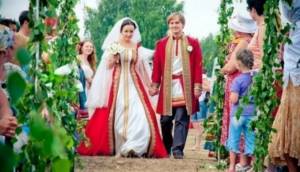
What does the veil symbolize?
Today's light, almost weightless, veil is a modified veil that was used to cover brides from head to toe. In Ancient Rome and Greece, people covered themselves completely in a veil, with the exception of the face. According to historians, it was bright yellow and was intended to scare away evil spirits. Some believe that such an inconvenient addition to the festive outfit served as a serious obstacle to the girl’s escape from the aisle.
Russian traditions at a wedding required that girls in a wedding dress be wrapped in heavy, opaque pieces of fabric with elegant embroidery. This procedure symbolized the death of the bride for her family, and the ritual of removing the veil in the groom’s house revived her for a new family.
In the East, a veil was not placed on the bride's head. A weightless, translucent piece of silk was kept between the young couple so that they could not touch each other until the moment of privacy in the bedroom.
Modern wedding customs are quite democratic. If fifty years ago a girl did not dare to wear a veil to a wedding, if she was not innocent, then today everything depends only on the tastes and preferences of the bride. You can decorate your outfit with a luxurious, long veil, a lace cape-mantilla in the Spanish style, or limit yourself to a modest veil attached to a flirty hat or headpiece. Or you can do without this attribute of an old wedding altogether. Often, instead of a veil, brides prefer to decorate their hair with a magnificent tiara, a wreath of fresh flowers, a hair net, beads and chains, and jewelry.

Wedding lamentations, voting
There is a superstition that the bride needs to cry on her bachelorette party and before the wedding, based on the old saying: “If you don’t cry at the table, you’ll cry behind the post.” In some localities, lamentations or voting still exist to this day, for example, according to Professor Snegirev, in Verkhovozhsky Posad, Svatanye, a bride, covered with a veil, among her maiden friends, sits on an elevated place with a skillful lamenter and begins to lament, that is, speak in a sing-song voice, a decent word or greetings to father and mother, brothers, sisters and all relatives, says goodbye to her home and, if she is extradited to a foreign land, then to her friends.
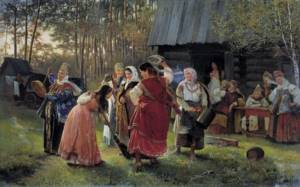
A.I. Korzukhin. Hen-party. 1889
Hosting a bachelorette party
This tradition is many centuries old. The custom prescribed to “see off” the bride with crying and sad, drawn-out songs. The bridesmaids got together on the eve of the wedding, visited the bathhouse together, and helped the bride comb and braid her hair. At the same time, she was enlightened about her new, married life and her responsibilities.
The bachelor party, which today is usually held at the same time as the bachelorette party, appeared relatively recently. Apparently, the grooms and their friends became jealous, and they decided to organize get-togethers in their own circle.
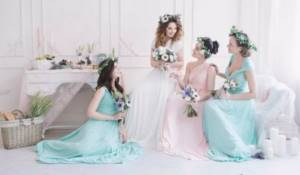
Parental blessing
Blessing the newlyweds for family life is one of the most important stages of an ancient wedding. In the old days, it was unthinkable to get married without the approval of older relatives. It was believed that without parental approval, young people would not see happiness and prosperity in family life. The blessing was given by the parents of the young, or their godparents, and in case of their absence or death, by the most respected senior relatives and guardians. The ritual is divided into two stages.
First blessing
The newlyweds receive it from the bride's parents on the morning of the wedding day. That is, immediately before visiting the registry office or the sacrament of wedding in the church. In the old days, this ritual was performed long before the wedding, on the day when the groom’s matchmakers received the consent of the bride’s parents for the marriage. But today the tradition of matchmaking is practically no longer used. How does the ritual work?
- The young people ask for a blessing from the bride's parents after the groom has paid the ransom for his beloved, passed all the tests that the relatives and bridesmaids could think of, and handed her a bouquet.
- During the entire ceremony, the girl is forbidden to cross the threshold of the house or go outside. It is believed that beyond the threshold the bride no longer belongs to her family, she begins a new life.
- They bless in different ways. An ancient custom prescribes spreading out an embroidered towel, on which the young people kneel. And the parents are holding in their hands an old, prayed-up icon, with which they baptize the newlyweds, saying kind parting words.
- Today you can get by with just good wishes and mutual hugs: parental approval is very important for children, even if they are already quite adults.
By blessing, the parents fully accept their daughter’s chosen one into their family and approve of her choice.
Second blessing
It is given to the young family by the groom's parents. According to established traditions, newlyweds must acquire the official status of a new family by going through the marriage procedure at the registry office, or by getting married in a temple (depending on national and family traditions). Previously, the ritual was performed on the threshold of the groom's house, where he brought his young wife. The action itself almost completely copied the morning blessing, except that the parents chose their own words. Today it is permissible to hold a ceremony at the site of the festive feast - in front of the entrance to a banquet hall, bar or cafe, in a forest clearing or on the shore of the sea, lake, or on board a ship.
Newlyweds who do not want to follow the old canons can include blessing ceremonies in the banquet script. Under the guise of one of the first toasts, parents will talk about the wonderful qualities of their children entering a new life, wishing love and harmony in family relationships, prosperity and prosperity. You can arrange the blessing in poetic form or even put on a small performance, showing children's photos and videos, the story of the newlyweds' acquaintance and love.

Blessing of the Young
In ancient times, young people could not marry without the consent of their parents - their blessing was required for the marriage, otherwise it was considered displeasing to God. Since the concept of wedding included a church wedding, the lack of family approval was a serious obstacle.
Interesting! Few couples decided to disobey their parents and get married without their knowledge.
Today the rules are not so strict. The priority is the official registration at the registry office, not the wedding, and parents no longer take such direct part in the decision on marriage. Blessing the newlyweds is only a symbolic rite. On the eve of the wedding, the groom's parents come to the lovers with an icon and a towel, read a prayer and say parting words.
The tradition of bride price
A significant percentage of newlyweds willingly include such an interesting and exciting game as bride ransom into the wedding scenario. They come up with complex competitions and puzzles, various fun challenges, and comic competitions. The groom must cope with all the tasks, or pay off the picky judges with money, sweets, and small souvenirs. Today, ransom is perceived as another wonderful opportunity to have fun at a wedding and make it truly unforgettable.
But the origins of this custom are not at all funny. In ancient times, there was a kind of property qualification for starting a family: only fairly wealthy young people could get married. A man had to provide his family with housing and livelihood. The ransom paid for the bride confirmed that the chosen one was rich enough to get married and raise children. Moreover, in the countries of the East, the bride price paid by the groom to the bride became her personal property, to which only the spouse had the right. In case of divorce, the bride price also remained with the woman. The Slavic peoples also had a tradition of ransom-veno, when the groom, before the wedding, ensured the future of his wife in the event of his death, transferring part of his property to her.

Wedding with pipes
At the weddings of Russian tsars and important boyars, in addition to songs, zurnas were played with trumpets, as is known from the description of weddings in the 17th century[3]. Such weddings were called weddings with trumpets. Tsar Alexei Mikhailovich, during his wedding to Natalya Kirillovna, ordered that instead of trumpets and organs, his sovereign choristers, clerks, and all villages should sing alternately lowercase and deminical large verses from holidays and triodes, good verses, with all deanery. The songs and main wedding rites ended with the performance of the church ceremony.
Common traditions during a wedding
Wedding traditions in Russia are already established; all the rituals listed below are usually performed.
Wedding rings
Wedding rings symbolize fidelity, mutual love, and devotion to one partner for life. Traditionally, purchasing wedding rings is the responsibility of the groom. The bride should not even see them before the wedding. In addition, signs strictly prohibit trying them on before the wedding, much less giving them into the hands of strangers. Even a jeweler should not touch rings with bare hands when selling - only with gloves or through a cloth.
According to Christian custom, rings should be in the form of simple, smooth hoops, without stones or patterns. There is even a sign that the mirror surface of wedding rings contributes to a smooth, comfortable family life. However, today the long-standing tradition is not carried out so strictly, and you can buy rings decorated with engravings, with precious stones, and exquisite three-dimensional patterns. It is believed that wedding rings cannot be removed until the death of the spouse, and their loss or breakage threatens big problems in family life.
Wedding birds
Even in paganism among the Lithuanians, on the first day of the wedding, the husband tore apart the fried partridge brought to his bed, part of which he gave to his wife to eat.
In the Middle Ages, the Germans gave newlyweds fried chicken, which was called marriage or love chicken. Fried chicken (evening smoke) was served to newlyweds on the first day in Russia, as can be seen from the descriptions of ancient weddings of the 15th century. In Moscow, to this day, young people are given a pair of live geese in ribbons, and even sometimes swans, and in the old days, fried swans were served on the tables of princes. There is a popular belief that swans are the only thing newlyweds can eat.
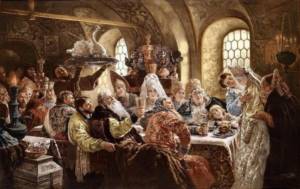
Konstantin Makovsky. Boyar wedding feast in the 17th century
Rituals for wealth and fertility
Everyone knows the custom of showering the young with grain. In Slavic culture, and in most countries of the world, grain is associated with fertility and prosperity. Consequently, by showering the newlyweds with grains after the wedding ceremony, they were wished many years of trouble-free family life, many children, and prosperity in the house.
Nowadays, this spectacular ceremony is held at the exit from the registry office, immediately after the official registration of the marriage, or on the steps of the restaurant, in the presence of all invited guests. If the wedding is held outdoors, the newlyweds walk between two rows of guests to the wedding arch.
What can you shower the newlyweds with?
- First of all, these are, of course, various types of grain, symbolizing numerous, healthy offspring. If you can’t find whole grains, cereals will do: wheat, oats, buckwheat, rice, millet.
- Small candies in bright candy wrappers promise newlyweds a sweet family life.
- Coins are a symbol of prosperity, financial wealth in the house.
- Flower petals (as a rule, these are roses of various colors, from burgundy-red to snow-white, but you can choose any other suitable flowers), multi-colored confetti indicate that the family life of the young should be filled with love, romance, strong emotions and impressions, respect for each other.
To make the ceremony look festive, the material for showering is distributed to guests in beautiful wicker baskets, decorated with ribbons, flower buds, appliqué, or in paper bags, decorated in full accordance with the theme of the wedding.
It is considered a favorable sign if, after the wedding, the newlyweds are greeted by as many people as possible, always with the presence of small children. When the wedding cortege leaves, the children race to collect the scattered coins and candies. For children this is a fun game, and for newlyweds it is a bright wish for the speedy birth of their first child.

Wedding rituals of Ancient Rus' that no longer exist

Some Slavic traditions, which are an integral part of the wedding ritual, have undergone significant changes or been altered in a different way:
- Matchmaking. This was the starting point of the entire wedding celebration. The betrothed girl was restricted in her movements; she was allowed to leave the walls of her home only when accompanied by her girlfriends. The young lady was freed from household chores.
- Bride. Three days after the matchmaking, the groom and his relatives came to “evaluate” the bride. Her dowry is also assessed. At this moment, the girl could refuse the wedding and not go out to the guests.
- Handshake. Securing the agreement to hold the wedding ceremony. After this, you cannot refuse the marriage.
| Hen-party. This ritual has not disappeared, but has been seriously transformed. Previously, these were farewell gatherings with songs and baths. Also in Ancient Rus', the bride and her bridesmaids created “beauty” (for example, a tree decorated with multi-colored ribbons). This was the last thing that connected the young lady with her girlhood. |
- Young woman's hairstyle. After the wedding, the bride had two braids braided and her hair covered with a scarf. Or they twisted the bun at the back of the head and attached a special headdress to it. From that moment on, only her husband had the right to admire the girl’s hair. To appear in public with your head uncovered was considered a disgrace, and to rip off your headdress was considered an insult.
- Unveiling of the bride. The newlyweds arrive at the guy's house after the wedding. The girl was “opened” by her father-in-law or her husband’s friend. The bride's hem was lifted using a grip or a stick.
- Bends. Newlyweds visiting the girl's parents. This ritual was of particular importance for the bride, who gets the opportunity to return to her father’s house for a short time.
Wedding loaf
The loaf, which was always baked for a wedding in Rus', promised the young couple a prosperous home full of prosperity. Its round shape and golden color symbolized the sun, giving light and warmth, joy in life. The wedding cake was richly decorated with figures made from dough, depicting ripe ears of corn, the sun, pairs of doves or swans, bunches of rowan berries, flowers and leaves - everything that reflects mutual love and family well-being in people's minds.
The loaf was carried out on a clean towel embroidered by the bride herself, meeting the newlyweds on the threshold of the groom's house. It always came with a cup of salt. The young people broke off pieces of bread, dipped them in salt and ate them. The meaning of this ritual is quite simple - they left behind all their sorrows and salty tears, entering a new, happy life. And the size of the broken piece indicated what gender the first-born would be: a girl or a boy. The towel was carefully kept in the young family, as part of the bride's dowry.
Later, another sign appeared related to the size of the pieces: whoever has the larger size will be the leader in the new family.
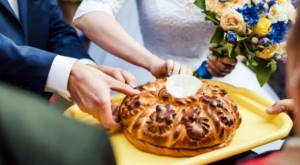
Meeting the newlyweds after the registry office
Before entering, the guests showered the young couple with rice and sweets so that their family life would be well-fed and comfortable. At the doorstep, the newlyweds are met by their groom's parents with a wedding loaf and salt. Icons are also used to bless the newlyweds.
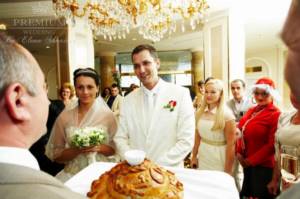
The blessing of parents plays a very important role in the wedding ceremony. Many newlyweds attach great importance to it - parental love will protect and protect their peace throughout their lives. According to tradition, the newlyweds take a bite of the wedding loaf, and whoever manages to bite off the largest piece will become the head of the family.
KNOWLEDGE BASE: Apple style wedding - a fresh aroma of happiness
Throwing the bride's bouquet
In the old days, only the groom was responsible for making a bouquet for his chosen one. After all, these flowers symbolized the strength of his feelings. He could get the rarest, most unusual flower for his beloved, from the tops of the mountains or from the depths of the forest, pick a bouquet of field daisies and cornflowers, or ask/buy luxurious garden flowers. Today this custom is practically not used: the bride chooses a bouquet to match her dress. And, as you know, the groom is strictly forbidden to see his wedding attire until the “X” day.
The most enduring, romantic traditions of Russian weddings are associated with the bouquet and boutonniere:
- the final part of the “bride price”, when, having gone through fire and water, heroically overcoming the obstacles that stand in the way, the groom finally gets to the coveted reward in the person of his chosen one. It is then that he gives her a luxurious wedding bouquet. If a girl accepts the gift, it means she agrees to get married;
- Previously, the beloved would take a flower from the bouquet given to her and give it to the groom as a sign of her favor. The happy chosen one pinned the plant to his suit, demonstrating to the whole world that the bride was going down the aisle of her own free will. Today, it is not customary to violate a perfectly calibrated composition compiled by the best florists. Therefore, the boutonniere is ordered along with the wedding bouquet in advance. But, if you wish, you can observe this beautiful, touching custom;
- Throwing the bride's bouquet into a flock of unmarried bridesmaids is another sacredly observed custom. Rarely is a wedding complete without funny attempts by girls to race to catch thrown flowers. With this gesture, the bride shares her good fortune with her unmarried friends. It is believed that the smartest and fastest lucky woman will get married before the end of the year, and the marriage will be favorable.
At modern weddings, the bride's garter is often thrown along with the bouquet. This custom came to us from Medieval Europe. The groom solemnly and beautifully removes the garter from the bride's leg and throws it to his single friends. The bride must dance with the lucky person who caught her wardrobe item. There is also a sign that this guy will soon be married.

First stage
The initial stage on the path to a wedding celebration is the matchmaking of the bride.
This is a very old and wise custom. Previously, young people did not get married without parental approval. It is for him that the groom comes to the bride’s parents, having first notified his parents of his intention to marry. If the parents were satisfied with the proposed candidacy, only then could they go to matchmaking. This custom often took place accompanied by matchmakers, however, it was possible to carry out the ritual without them. You need to go to the bride’s house with two bouquets of flowers: one is intended for the beloved, and the other for the future mother-in-law. The young man must ask the bride's father for his hand in marriage. The role of matchmakers is to reduce the bride price, so they try to find flaws in the girl. The final say belongs to the father of the bride. If he gives his permission for the marriage, then you can begin to prepare for the wedding: discuss the costs of the upcoming celebration, set a date, prepare the bride’s dowry, etc.
After all the preparations and chores are completed, the wedding day comes. Not everyone knows how to organize it correctly. But there are older relatives, more experienced in these matters, who will help do everything as it should. The wedding day begins with the newlyweds getting ready, bustle and laughter reign all around. Young people gather, naturally, in different houses. Close friends and girlfriends help the bride and groom get ready.
The beginning of the wedding is considered to be the bride price
There are many options for redemption, it all depends on the imagination of the closest bridesmaids. Previously, ransom meant a certain amount of money; today, ransom is a whole series of tests that the groom must go through before he can take his betrothed.

The groom, smartly dressed, along with his friends in several cars, is driving behind his beloved. The wedding “train” can be seen and heard from afar: elegantly decorated cars honk in different ways, in addition, music can be heard - everyone knows that it is the groom coming.
At the bride’s house, the company “unexpectedly” encounters an obstacle organized by the bridesmaids, who demand a ransom. This is the last step on the way to the bride, so they want to “sell” the product (the bride) at a higher price. The girlfriends come up with various competitions and test the groom to see how much he knows his chosen one. It just seems that everything is simple: pay and get a bride. No! The girlfriends put on a whole performance, ask unexpected questions to the groom, try to confuse him, force the guy to guess riddles, sing and declare his love, etc. If he answers tricky questions incorrectly, it doesn’t matter, but you will need to pay off (this could be money, champagne, sweets, whatever the bridesmaid wishes). Nothing is a pity for your beloved. When all the trials are over and all obstacles have been overcome, the groom gives his beloved a wedding bouquet and the next step is the registry office.
First kiss
Initially, the bride and groom kissed for the first time at their wedding, in the presence of relatives, respected elders, and honored guests. It was believed that with a kiss, not only breath is united - the souls of the young are united. A public kiss announced to everyone present that from now on the couple was a single whole.
Today, premarital couples have less chaste relationships. But how exciting is the first kiss in front of all your friends and relatives! It seems to consolidate the rights of young people to each other, adding romance and love to the relationship.
Festive feast
The celebration continues in a cafe or restaurant, where everything is ready for the arrival of the newlyweds. The decoration of the hall, tables and menu are usually chosen in advance.
This is a separate topic worthy of a huge post. Now we are talking about the traditions of the wedding feast.
Congratulations
The whole holiday is organized in such a way that special attention is paid to congratulations: everyone will have time to congratulate! Usually the parents are the first to congratulate, they are given the floor, and they seem to bless the children for marriage.
Afterwards, relatives congratulate: first on one side, then on the other, and then friends. Often, the bride prepares a special box in advance, in which she places envelopes with money so that they do not get lost.
Dancing
After the guests have eaten, the dancing begins. But here, too, traditions cannot be avoided. The first dance of the bride and groom is obligatory. Recently, it has become fashionable to prepare this dance in advance, to make it unusual, brides change their dress for the dance, grooms can also change clothes. Of course, such dances are remembered by guests.
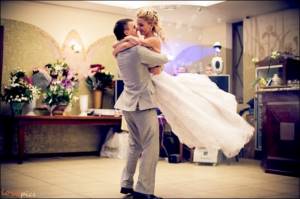
Another dance, without which it is difficult to imagine a Russian wedding, is the dance of the bride and her father. With this dance, the father seems to be escorting his daughter to another family, saying goodbye to her. This touching dance reminds that a completely new time is coming in the bride’s life.
Family hearth
An ancient tradition that is still popular today. How to spend a family hearth?
- Organizers and assistants hand out small candles to guests.
- Guests stand in a circle and light candles.
- The lights in the hall turn off.
- To the accompaniment of slow music, the presenter tells a parable about a family hearth.
- Parents light their candles and approach the young people.
- A new candle flame is created for the newlyweds - a family hearth.
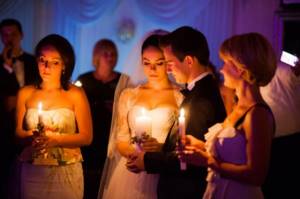
Ritual of removing the veil
According to tradition, at the end of the holiday, the mother-in-law or mother of the bride removes the veil. At first, the bride should not agree, only the third time does the mother manage to persuade her to remove the veil.
After the veil is removed, the groom undoes the bride's braids. During the ceremony, the leader usually explains what is happening and tells the story of the ceremony. This wedding moment always turns out to be very touching.
Tradition is bitter at a wedding
Shouts of “Bitter!” calling newlyweds to kiss is a purely Russian phenomenon. At almost every wedding you can hear these cheerful exclamations. Where did this custom come from?
Oddly enough, this word, according to one version of historians, has nothing to do with kissing. Initially, the bride’s duties included honorably serving all guests with vodka or another strong alcoholic drink. Those present took glasses from the tray, giving money or other valuable gifts in return, after which they drank the offering and shouted “Bitter!” as a sign that the drink was really strong and went well.
The second version is closer in meaning to the modern custom: this word was shouted by guests during the kiss of the bride and groom to ward off evil spirits. It was believed that the evil spirits, deceived by the exclamations of the guests, would not harm the newlyweds, because they were, after all, having a hard time. According to the third legend, the guests warned the bride and groom with their exclamations that the wine was bitter and should be sweetened with a strong, sweet kiss.
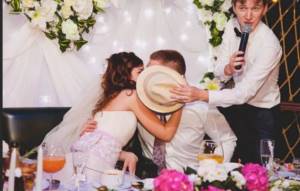
Classic
The bride and groom rarely ignore these traditions, because they are designed to strengthen family ties, and make the wedding day even more exciting and interesting.
Exchange of rings
As many probably know, wedding rings symbolize love, fidelity and devotion, so it is customary to wear them after painting and not take them off. Breaking or losing such a ring was considered a bad omen, which foreshadowed an imminent divorce.
Exchanging rings is a fairly old ritual that has survived to this day. But, of course, the most significant thing in married life is not the jewelry itself, but real and sincere feelings.

Padlock
Another ritual that is also popular at modern weddings is a lock that lovers attach on the day of their holiday in a pre-selected place. The newlyweds had to throw away the key to it, this meant that the lock would hang forever and would never open, just like a new family, it would always be together and would not fall apart.
Nowadays, you can order a lock with a beautiful engraving in the form of the names of the husband and wife, the date of the celebration, and so on.
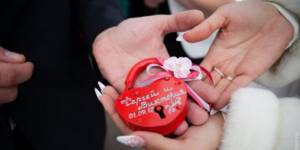
Pigeons
After the end of the official part, many newly-made spouses hold a touching ceremony - they release a white dove and a dove into the sky, because they personify love and peace in the family.

Bread and salt
One of the most ancient customs, but still present at wedding ceremonies today, is the meeting of those getting married by their parents with a loaf of bread or, as they also say, “bread and salt.” Such bread was considered a symbol of abundance and good luck in marriage. It was most often round in shape, and it was usually decorated with figurines of swans or ears of wheat, because this signifies prosperity in life together, happiness in marriage and a quick increase.
According to this tradition, the bride and groom take a bite of a loaf of bread together; the piece that ends up being larger becomes the main one in the house.

Break glasses
At almost every wedding you can see the newlyweds breaking glasses. This action was believed to bring good luck and harmony into the marriage. The more glass fragments you get, the longer the couple will have a happy life together.
To carry out this custom, it is best to prepare other glasses. After all, it is not recommended to beat holiday ones, since traditionally it is customary to keep them throughout life, and use them only on special occasions, for example, for the birth of a child or a marriage anniversary.

"Bitterly!"
Exactly “Bitter!” shout the guests gathered at the wedding. There are three explanations for this that our ancestors came up with:
- According to one version, this custom is associated with superstition, according to which evil spirits can ruin both the wedding day of the newlyweds and married life in general. And to prevent this from happening, the guests began to shout “Bitter!”
- In ancient times, this was not a call for a kiss at all. The newly-made wife served vodka on a tray for the guests, they drank a glass, and in return they put money or gifts, and then shouted “Bitter!” With this action they confirmed the bitterness of the strong drink.
- According to the third legend, those gathered at the celebration shouted “Bitter!” so that the spouses would sweeten the wine with their sweet kiss.

Newlyweds' first dance
A very romantic tradition that reflects the feelings, relationships and harmony of a couple in love.
Don't be afraid of the wedding dance and treat it as a test. Even if you don’t know how to dance at all, you don’t have to spin in a waltz, you just need to learn a couple of moves and dance to your favorite modern composition.
Advice. If you want to show off in front of your guests, then hire a professional choreographer who will put on a beautiful number for you and teach you how to move correctly.

Daughter dancing with father
There is also such a touching tradition as a daughter dancing with her dad at her wedding. It is quite common during such a speech to include on the screen a slide show with childhood photos of the bride and her father.

Family hearth
This ritual dates back to the times of ancient Rus'. Then the parents of the newlyweds lit candles, that is, the family hearth, and then passed the fire from them to the candles of their children. It was believed that in this way relatives shared their experience, wisdom, traditions, love and warmth with the newlyweds.

Bouquet and garter toss
Probably the most famous and popular custom is throwing a bouquet and garter into a crowd of unmarried and unmarried guests. The next wedding is predicted for the girl and guy who catch them.
The newlywed’s bouquet is most often protected, and a small backup bouquet is specially ordered for throwing. After all, a voluminous, heavy attribute is inconvenient to throw, and the flowers in it can break, which will darken the mood of the guest who caught it.
A duplicate bouquet can be made of artificial flowers, multi-colored ribbons, and so on.

Nowadays, many brides do not follow this tradition and do not throw a bouquet at all, but give it to a specific friend. Sometimes they specially order several wedding flower arrangements for all their single bridesmaids and distribute them during the reception, this way no one will be offended and everyone will be happy.
As for garters, in our time some grooms replace them with butterflies or boutonnieres, which they throw away.

A wedding cake
The custom of treating a wife and husband to a birthday cake and cutting it together came to us from Ancient Rome; such an action meant the joining of two families together.
In the modern world, almost all newlyweds have adopted this tradition. After all, at almost every wedding there is a chic sweet delicacy that decorates the celebration and emphasizes the individuality of the young couple. There are now a huge number of cake options: with berries, flowers, fruits, artistic painting, and interesting figures. Which dessert to choose most often depends on the style and format of the wedding day.
The classic serving of the cake occurs at the end of the evening; it is rolled out on a table with wheels or a special trolley. The spouses cut the first piece together, which they feed each other or give it to their parents with words of gratitude.

Serving the wedding cake
Breaking bread together has always meant unity and fraternization. This is precisely the meaning that is put into the custom of ceremoniously treating a festive cake or pie, which came to us from Ancient Rome. A magnificent wedding cake is served at the end of the banquet, being its culmination. The young people work together to cut the delicacy and give pieces to everyone present, indicating that from now on all guests are members of one, friendly family.
The wedding night
The sacrament of the first night ends a long, eventful and emotional wedding day. For an innocent girl this is a very important event, and for the groom it is a crucial moment. The wife is carried into the house in their arms like a newborn baby, because for the new family the young wife has just been born.
In order to confuse the evil spirits, a non-standard place for holding the sacrament was chosen, strange from the point of view of a modern person: a hayloft, a haystack, a barn, a cage under the stairs, someone else's house. Hence the widespread custom of renting hotel rooms or apartments, houses at recreation centers for the wedding night, and also spending it in a very special environment - on board an ocean liner, in another country, on the coast of a tropical island.
Traditions at weddings these days change flexibly at the discretion of the young, because the possibilities for creativity and imagination are truly inexhaustible. You can spend this day in the mountains or at the sea, on the roof of a skyscraper or in unrestrained dancing, surrounded by friends and relatives, or in romantic solitude. Only one point of the program remains unchanged - registration of marriage at the registry office. But it can also be postponed to any other day, so as not to overshadow the personal holiday with officialdom.
Bride's matchmaking

This old custom has a wise and correct origin. Young people did not marry without parental approval. This is precisely why the groom came to the bride’s house. First, the groom notified his parents of his intention to get married; if they were not against the bride’s candidacy, then only then did he go to get married. Moreover, matchmaking could take place both with matchmakers and without them.
A young guy asked the girl’s father for his daughter’s hand in marriage. Arriving at the bride's house, the groom presented two bouquets: one to his future mother-in-law, the second to his future wife. Matchmakers deliberately tried to find shortcomings in the bride in order to “bring down” the ransom price. The father had the final say. If he allowed preparations for the wedding to begin, then wedding expenses, the wedding date, the bride price and her dowry were immediately discussed.











